Brief description
Data set from the study: Increasing Physical Exercise through Action and Coping PlanningFull description
This study aims to explore how action and coping planning can help to increase physical activity levels of a normal healthy population consisting of young adults within a short time duration of two weeks.
The study was delivered through Qualtrics software, Version 2020 (Qualtrics, Provo, UT, https://www.qualtrics.com ). To reduce attrition rates, participants were sent a reminder email through Qualtrics at the mid-point of the study (i.e., one week after T1) to encourage them to continue their exercise plans according to their intentions and plans stated at T1. Participants were provided with summary information about the study in a prefacing page to the questionnaires. Participants were invited to provide informed consent to participate, verify they were above 18 years old, confirm that they were keen to increase their physical activity levels, and agree to complete the measures at both T1 and T2 as well as to be contacted with reminder emails containing instructions.
The T1 measures were the IPAQ past 14 days, IPAQ intentions next 14 days, ACPS, elaborate their plans, IMI, and demographics including past and/or current injuries. The T2 measures were the IPAQ past 14 days, perceived effectiveness of planning, and confidence in continuing their levels of physical exercise beyond T2. They were also given an option to opt out of the study without penalty and asked if they had answered truthfully at the end of the questionnaire for both time points
The full methodology is available in the Open Access publication from the Related publications link below.
This dataset consists of 4 SPSS data files (saved in .sav and .csv formats) including the merged and cleaned data file (available via conditional access), the analysis set, raw T1 and raw T2 which are restricted. The codebook for the merged and cleaned data file is available from the link below.
Software/equipment used to create/collect the data: Qualtrics Survey Software
Software/equipment used to manipulate/analyse the data: SPSS
Created: 2022-07-04
Data time period: 07 2020 to 07 2021
Data time period:
During COVID-19 pandemic
dcmiPoint: east=103.860882; north=1.355801; projection=WGS84
text: Singapore
User Contributed Tags
Login to tag this record with meaningful keywords to make it easier to discover
- DOI : 10.25903/VA27-9G82

- Local : researchdata.jcu.edu.au//published/227d22b0ab1211ec89127f82c5757d8a


